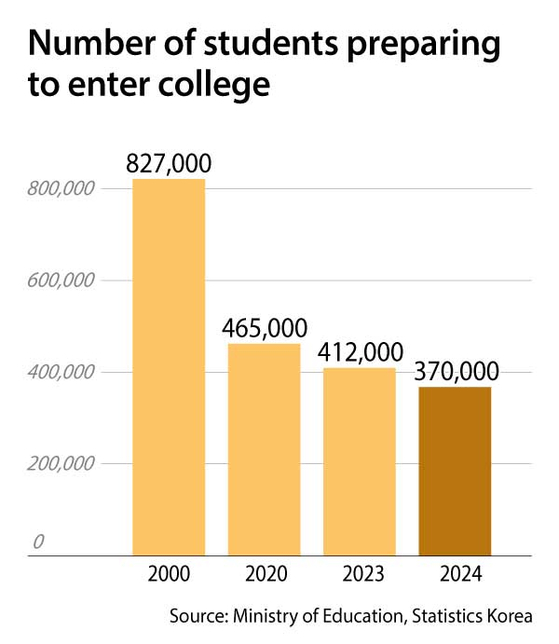Regional universities stand empty as number of students continues to fall
Published: 16 Mar. 2023, 17:56
Updated: 21 Mar. 2023, 10:14
![A classroom at a four-year private university in North Gyeongsang stands empty with an outdated computer visible on the professor's desk on March 6, the first Monday after the academic year began in Korea. [LEE HOO-YEON]](https://koreajoongangdaily.joins.com/data/photo/2023/03/21/018f7332-0778-44dc-ba2c-c61496639a68.jpg)
A classroom at a four-year private university in North Gyeongsang stands empty with an outdated computer visible on the professor's desk on March 6, the first Monday after the academic year began in Korea. [LEE HOO-YEON]
The Korean academic year kicked off at the start of March, with students flocking to university campuses across the country in their thousands to resume their studies or begin their higher education journey.
But the further you head from Seoul, the fewer students you are likely to see. Regional universities across the country are struggling with a chronic lack of students, leaving courses undersubscribed and, in the most extreme cases, schools forced to merge with each other to stay afloat or even close their doors completely.
The campus of a four-year private university in North Gyeongsang stood completely empty when the JoongAng Ilbo visited on March 6, the first Monday after school semester began. Classrooms at the university were empty and dark.
“I’ve not seen a single student,” a cleaner at the university that asked not to be named told the JoongAng Ilbo, admitting that they were not even aware the semester had actually started.
According to a university employee who also requested anonymity, “barely any freshmen registered this year, so the university did not even hold an official entrance ceremony.”
The school this year had places for 633 freshmen, but only 74 people applied. Among the 20 departments at the university, 11 didn’t get a single applicant.
When the school tried recruiting 440 students during the additional college admissions period, only 26 applied.
"We have about half as many professors at the university as we did a decade ago," a professor told the JoongAng Ilbo.
The story is the same for a number of regional universities.
A four-year private university in North Jeolla faces a similar crisis. While the school had space for around 700 freshmen this year, admissions were so low that it had to offer 570 spots during additional college admissions.
When the JoongAng Ilbo visited the university on March 10, the university’s cafeteria at midday was almost empty, with less than 10 students eating lunch there.
University clubs are also suffering as there are too few freshmen to recruit.
The lack of students also comes as a blow to restaurants and cafes operating nearby, serving a double blow with the impact of the Covid-19 pandemic on sales also felt especially keenly in university neighborhoods.
During the regular college admission period this year, 14 universities had departments that had zero applicants and they were all outside of the greater Seoul area, according to data accumulated by Jongno Hagwon, a chain of cram schools that helps students prepare for the nationwide college entrance exam called College Scholastic Ability Test (CSAT).
![A studying room at a four-year private university in North Gyeongsang is empty on March 6 eventhough a new semester has begun. [LEE HOO-YEON]](https://koreajoongangdaily.joins.com/data/photo/2023/03/21/1ed3db04-676b-4530-b858-a5be14d1a984.jpg)
A studying room at a four-year private university in North Gyeongsang is empty on March 6 eventhough a new semester has begun. [LEE HOO-YEON]
In 2020, there were only three universities that had the same problem.
According to Higher Education in Korea, a website run by the Korean Council for University Education to show university filings, 15,540 freshmen at four-year universities outside of the greater Seoul area left their school in 2021. That number is roughly 60.6 percent of the total freshmen who quit school that year.
The problem is only going to worsen in the coming years as the student population shrinks dramatically due to Korea's low birthrate, creating an increasingly severe risk for universities outside of Seoul.
The number of students that are the right age to enter college this year, those born in 2004, amounted to 477,000. That number will drop eight percent next year as 438,700 children were born in 2005.
As Korea’s student population continues to decline, regional universities are striving to attract international students and mature students who want to revisit their lost learning opportunities.

Some other universities are giving special perks to mature students by waiving some tuition fees.
To enhance the competency of regional universities, the Education Ministry set up a committee consisting of 22 experts from academia, business, media and science and held its first discussion meeting on Monday.
The ministry hopes to make a group of so-called glocal universities, combining the word global and local, by supporting a select group of universities with funds and closely monitoring their performance.
This year, the ministry will select some 10 universities and by 2027 some 30 universities located outside of the metropolitan area to nurture them as competent glocal universities. The selected universities will receive 100 billion won ($76.8 million) in funding over five years and some regulatory benefits.
According to the ministry Thursday, the universities can apply to become a beneficiary by submitting a five-page document explaining how they will transform their operations, including academic programs, international student recruitment programs and business plans.
“We will totally reform our university support strategy so that universities can survive through a bold transition,” said Lee Ju-ho, deputy prime minister and minister of education, during the committee meeting held Monday at a convention center in Jung District, central Seoul. “I believe a movement started by glocal universities can lead to a massive transition for many other regional universities.”
BY LEE HOO-YEON, KIM JEE-HEE [kim.jeehee@joongang.co.kr]










with the Korea JoongAng Daily
To write comments, please log in to one of the accounts.
Standards Board Policy (0/250자)